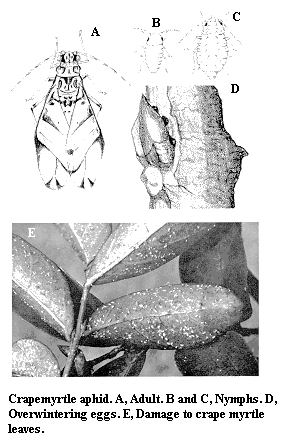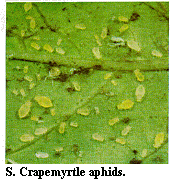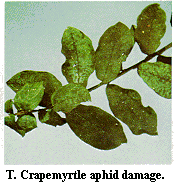Key to Crape Myrtle Pests
The crape myrtle was first brought to the Southeast by early settlers. Originally from Asia, this shrub or small tree had lavender or purple flower; red and white varieties are now available as well. All varieties have showy flowers and are susceptible to relatively few insect pests. In view of the many attributes of this ornamental plant, it is surprising that fewer than 250,000 are produced and sold by Southern nurserymen each year.
- Crapemyrtle aphid - The foliage is covered with sooty mold and honeydew excreted by aphids; the small, green aphids are visible on the lower surfaces of leaves.
Crapemyrtle Aphid
Crapemyrtle aphid, Tinocallis kahawaluokalani (Kirkaldy), Aphididae, HEMIPTERA
DESCRIPTION
Adult – Pale yellowish green with black spots on the abdomen, the winged adult is just over 1.5 mm long. It has dark-tipped antennae and two double-pronged humps on the abdomen. The wingless adult is also yellowish green with bumps on the body, dark antennae, and dark hairs (Figure S).
Nymph – Except for its smaller size and lighter pigmentation, the nymph resembles the wingless adult.
BIOLOGY
Distribution – Crapemyrtle aphids were first discovered in Hawaii, though they are now known to be in China, Formosa, Japan, and North America. In the Southeast they are found wherever crepe myrtles are grown.
Host Plants – Crape myrtle is the only known host of this aphid.
Damage – The crapemyrtle aphid is the only significant insect pest of crepe myrtles in the Southeast. Because it feeds on the lower surface of crepe myrtle foliage, it is inconspicuous except for the copious amounts of honeydew that it excretes. A sooty mold, Capnodium sp., grows in the honeydew and thus alerts the grower to his aphid problem (Figure T). In addition to being unsightly, this black mold blocks light from the leaves. Because the foliage may drop prematurely, a plant can be in deplorable condition by midsummer. During some years, the aphid population may be kept in check by lacewings and ladybird beetles.
Life History – Very little information is available on the biology of the crapemyrtle aphid. In the Southeast, this pest is found on the foliage of crepe myrtles from late April through September. Winged and wingless forms are present during these months. Reproduction, the birth of living young, occurs especially during the summer season.
CONTROL
The sooner this aphid is discovered and treated in the growing season, the better. Pesticides should be directed against the bottom of the foliage. For specific chemical controls, see the current state extension recommendations.
Publication date: Jan. 1, 1993
Reviewed/Revised: Aug. 9, 2024
AG-189
Other Publications in Insect and Related Pests of Shrubs
N.C. Cooperative Extension prohibits discrimination and harassment regardless of age, color, disability, family and marital status, gender identity, national origin, political beliefs, race, religion, sex (including pregnancy), sexual orientation and veteran status.



